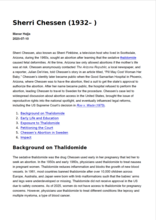Filter my results


In 2015, Mats Brännström and colleagues published “Livebirth after Uterus Transplantation” in the journal The Lancet. In “Livebirth after Uterus…
Infertility, Femaleorgan transplantationClinical trialIn vitro fertilizationPregnancy
Sherri Chessen, also known as Sherri Finkbine, a television host who lived in Scottsdale, Arizona, during the 1960s, sought an abortion after…
Abortion, IllegalAbortion HistoryReproductive RightsMedia ExposureThalidomide
Mary Dinsmore Salter Ainsworth conducted research in the United States, the United Kingdom, and Uganda, in the mid-twentieth century, on how…
psychologyPsychology, DevelopmentalFamily TherapyAttachment behavior in childrenAttachment disorder
Mary Frances Lyon studied gene expression and developed the theory of X-chromosome inactivation, also called Lyonization, during the twentieth…
Gene ExpressionX Chromosome InactivationLyon HypothesisLyonizationMutation
Oliver Smithies researched physical chemistry, biochemistry, and genetics in England, Canada, and the United States during the twentieth and early…
Genetic TechniquesElectrophoresis, Starch GelMice, KnockoutGenetics--ResearchElectrophoresis
Charles Richard Drew was an African American surgeon who helped improve blood transfusion practices during World War II and contributed to the…
Blood TransfusionMaternal MortalityBlack or African AmericanBlood banksAfrican Americans in medicine
Ernest Armstrong McCulloch was a medical researcher who studied the biology of blood cells and blood cancer in Toronto, Ontario, in the second half…
Hematopoietic Stem CellsHematopoiesisLeukemia, Myeloid, AcuteScientists--BiographyAcute myeloid leukemia
Irving Lerner Weissman is a researcher and professor in developmental biology at the Stanford University School of Medicine in Stanford, California.…
Stem Cell ResearchHematologic NeoplasmsImmunologic TechniquesStem CellsImmunology
Arizona Revised Statutes 13-3603 (1864), or ARS 13-3603, was a territorial law enacted in 1864 before Arizona was granted statehood that banned…
Abortion, InducedAbortion, LegalReproductive RightsAbortion--Law and legislation--United StatesArizona--Politics and government
Arizona Senate Bill 1164 (2022), or SB 1164, prohibited abortions after fifteen weeks of pregnancy except when necessary to protect the life or…
Abortion, InducedAbortion, LegalReproductive RightsAbortion--Law and legislation--United StatesArizona--Politics and government